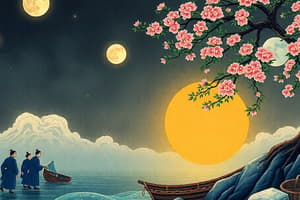Podcast
Questions and Answers
What are the basic components or building blocks of a traditional East Asian painting?
What are the basic components or building blocks of a traditional East Asian painting?
- Brush, canvas, easel, and palette
- Oil, acrylic, watercolor, and pastel
- Color, tone, line, shape, and texture (correct)
- Red, blue, green, and yellow
Which materials are typically used in traditional East Asian calligraphy?
Which materials are typically used in traditional East Asian calligraphy?
- Wood and metal
- Canvas and acrylic paint
- Paper and silk (correct)
- Clay and pottery
What distinguishes Korean knots from Chinese knots?
What distinguishes Korean knots from Chinese knots?
- They have a different shape
- They are tied without the use of tools (correct)
- They are made of different materials
- They are only used by royal families
What is the historical usage of traditional Korean knots?
What is the historical usage of traditional Korean knots?
What is the religious significance of Korean masks?
What is the religious significance of Korean masks?
What is the primary role of Chinese calligraphy?
What is the primary role of Chinese calligraphy?
What are the primary materials used in traditional East Asian calligraphy?
What are the primary materials used in traditional East Asian calligraphy?
What is the historical usage of traditional Korean knots?
What is the historical usage of traditional Korean knots?
What is the significance of Chinese calligraphy according to the text?
What is the significance of Chinese calligraphy according to the text?
Where were some of the prehistoric paintings found according to the text?
Where were some of the prehistoric paintings found according to the text?
What is the primary function of Korean masks according to the text?
What is the primary function of Korean masks according to the text?
What differentiates Korean knots from Chinese knots according to the text?
What differentiates Korean knots from Chinese knots according to the text?
What are the main elements of painting according to East Asian art as mentioned in the text?
What are the main elements of painting according to East Asian art as mentioned in the text?
What is the significance of composition in art as per the text?
What is the significance of composition in art as per the text?
What is the primary focus of traditional East Asian painting techniques based on the text?
What is the primary focus of traditional East Asian painting techniques based on the text?
What is common in terms of behavior among East Asian countries according to the text?
What is common in terms of behavior among East Asian countries according to the text?
What is a defining characteristic of anime characters?
What is a defining characteristic of anime characters?
What is the primary function of woodblock printing as mentioned in the text?
What is the primary function of woodblock printing as mentioned in the text?
What distinguishes Korean theater masks from Japanese theater masks?
What distinguishes Korean theater masks from Japanese theater masks?
What differentiates manga characters from traditional Western comic characters?
What differentiates manga characters from traditional Western comic characters?
What is the primary usage of Korean masks according to the text?
What is the primary usage of Korean masks according to the text?
What is a characteristic of Shui Mo in East Asian art?
What is a characteristic of Shui Mo in East Asian art?
What is the main objective of Origami in East Asian art?
What is the main objective of Origami in East Asian art?
What is the significance of Gong-bi in East Asian art?
What is the significance of Gong-bi in East Asian art?
What is the characteristic of Calligraphy in East Asian art?
What is the characteristic of Calligraphy in East Asian art?
What is the main focus of Japanese Origami according to the text?
What is the main focus of Japanese Origami according to the text?
Flashcards are hidden until you start studying
Study Notes
- East Asia includes China, Japan, North and South Korea
- Cultures have unique traditions but also common elements: strong public behavior conventions, varied art and religious influences, prehistoric painting with hunting scenes
- Prehistoric painting: ochre and black pigment, cave walls, some found in China
- Composition: term for arrangement of visual elements in art, includes line, shape, color, value, texture, form, space, balance, contrast, movement, pattern, rhythm, unity/variety
- Korean painting: same techniques as calligraphy, brush and ink, various media
- Korean knots: traditional handicraft, bilateral symmetry, wide use historically, modern artists use in work
- Korean masks: religious origins, used in funeral services and theater, various uses throughout history
- Chinese calligraphy: ancient expressive art, abstract beauty of lines and rhythms, reflects person's character and emotions
- Characteristics of East Asian arts: diverse art forms, China: gong-bi painting, ink and brush painting, calligraphy; Japan: origami, theater masks, anime, manga.
Studying That Suits You
Use AI to generate personalized quizzes and flashcards to suit your learning preferences.




